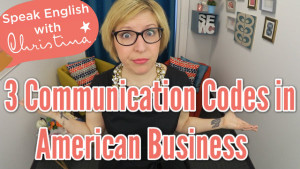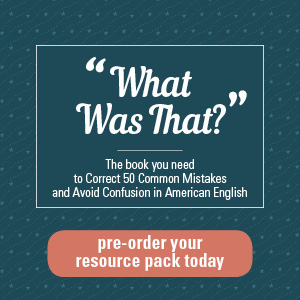
This, that, these, those…They’re all words we use to indicate things or people. You’ve studied them before…BUT…You might not be super confident using them.
When you get to an advanced level of English, there are a few special situations you need to know about.
And…you might have noticed already that there are actually a LOT of rules about how to use this, these, that, and those. And that it can get a little confusing to learn them all!
I know how that feels. When I was learning French, some grammar topics were difficult for me. There were too many rules…and too many exceptions!
When I became a neurolanguage coach, I learned that learning too many grammar rules at once is stressful–and not helpful. So today, we’ll focus on just a few situations…and then you can practice those until you feel confident!
In today’s lesson, we’ll start out with a quick and simple overview.
And then we’ll move on to a few specific situations you’re likely to run into in a Business English setting.
Get the worksheet to test what you learn in this lesson!
Did you know that I’ve made a worksheet to go with this lesson so that you can practice everything you see here today? I want you to make this part of the English you actually use in real life!
GET THE WORKSHEET: Make sure you practice these expressions so you can use them in real life with this worksheet made for you by a Neurolanguage coach.
Index:
1. This, That, These, Those: a review of how to use them
2. Business English Situations: this + time (now)
3. Business English Situations: this + time (future)
4. Business English Situations: that/those + something in the past
5. Business English Situations: that/those + a negative opinion
6. Business English Situations: this/these +a positive opinion
1. This, That, These, Those: a review of how to use them.
Let’s start with a review of the rules before we get into specific situations.
What can you tell me about…
this, that, these, those?
They’re all words we use to indicate things or people. In English, we call these words “demonstratives.”
And in general, how we use them depends on whether we’re indicating something or someone near or far. And how many things or people we’re talking about.
For people & things that are close use this/these.
If you’re talking about something or someone nearby or closer to you, you’ll use this or these.
For people and things close to you and singular use this.
For example, you might say,
“Is this your phone? You left it in the meeting room.”
Or
“This is my coworker, Sixtine.”
For people and things close to you and plural use these.
If you’re talking about something or someone close by in the plural use these.
To introduce some members of your team who are nearby, you could say:
“These are my colleagues, Karyn and Matthew.”
If you’re talking about some prototypes you have in the same room, that a member of your team is showing you, you could say:
“These prototypes are great.”
Or just
“These are great!”
For people and things farther from you use that/those.
When something or someone is a little farther away–not right there with you, you’ll choose from that or those.
For people and things farther from you and singular use that.
Use “that” to point to someone or something singular…but far from you.
If you’re with your colleague and you see a phone on the other side of a room you might say,
“Is that your briefcase? I think you forgot it over there.”
For people and things farther from you and plural use those.
If you’re at a conference and you want to tell your colleague about some posters you saw on display in another room you might say,
“Did you see those posters about climate change in the auditorium?”
There is more than one, they’re farther away.
Also check out my lesson: Prepositions of Place: on, off, at – Learn their Correct Usage & Examples.
2. Business English Situations: this + time (now)
When you want to talk about dates or times and use words like
morning, afternoon, evening, week, month, or year…
Use “this” if you mean the time we’re currently in. An important thing to know for scheduling!
For example, you could say,
“I’m so busy this week! And it’s only Monday!!!”
“This month, we’re focusing on our new product launch.”
In these examples, you’re talking about the week or month we’re currently in. The present.
3. Business English Situations: this + time (future)
You’ll also use “this” if you are talking about the time that’s coming with the expressions: morning, evening, weekend.
You might say,
“Will you be at the conference this weekend?”
“This evening, I’ve got a meeting with the board.”
To avoid confusion, use next + week, month, year (future).
To be sure you’re talking about a future week, month, or year and not the current one (or the present) use next. For example,
“I’ll call you next week.”
Or
“Let’s meet again next month to discuss our strategy.”
GET THE WORKSHEET: Make sure you practice these expressions so you can use them in real life with this worksheet made for you by a Neurolanguage coach.
4. Business English Situations: that/those + something in the past
When you’re talking about something or someone that you saw in the past use that or those.
To congratulate your team member on something from yesterday, you’d say,
“That conference call went really well!”
If you met some new business contacts the other day and you want to talk about them, you could say,
“Those people from Awesome Corp were so easy to work with.”
5. Business English Situations: that/those + a negative opinion
When you’re not feeling so positive about a person or situation, you might use that or those–to create distance from them!
If your team member has some difficult new clients you might say,
“Those new clients are difficult to manage!”
Or if you’re talking about a restaurant that you just went to and didn’t appreciate very much, you might say…
“Oh, you mean that restaurant with those rude waiters and that expensive food? I don’t know why anyone would go there…”
Just don’t say that to your boss if he has just suggested you schedule your next business lunch there!
6. Business English Situations: this/these + a positive opinion
We use this and these to talk about things we like that are in proximity to us. It’s as if we didn’t mind being close to them!
For example, you might say,
“I love these new slides you’re using for your presentation.”
“This new office is great!”
GET THE WORKSHEET: Make sure you practice these expressions so you can use them in real life with this worksheet made for you by a Neurolanguage coach.
Now you’re ready to practice using this, that, these, and those in a business setting.
Now you’ve reviewed how to use this/these/that and those. Plus you’ve learned about a few very specific situations you can use in your Business English. If you take some time to practice these and learn them, you’ll feel more confident the next time it’s time to use them.
Take the next step: Improve your English in the comments
The best way to become more confident using Business English is to practice!
Here’s your Confidence Challenge for this week:
- Write a sentence in the comments with ‘this’ as if you were scheduling a business meeting (this evening, this week…etc).
- See if you can use that sentence later in the week when you are speaking English.
If you learned something from this lesson, please share it with your coworkers & friends. You can send your message to them in English for more practice!
Click here to share this article on LinkedIn
Click here to share this article on Facebook
Become more fluent & comfortable in conversations
If you would like to take the next step with me, discover my Faster Fluency Conversation Club Membership Program!
It helps you become more confident speaking in conversations, and get a lot more vocabulary on many different topics! And it’s a fabulous community of “English buddies” from around the world!
TIP: Use the code FFCC40 to save -40% off your 1st month of membership!
More details at
https://mybusinessenglishcourses.com/faster-fluency-conversation-club/join-now
Can’t wait to see you in the Club,
Christina
More good stuff…
Click the image to learn more








Hi Christina,
Very helpul video and I learn something too so thank you 🙂
Here my example: I have to prepare a presentation this week and I have a lot of work to do!
Very good, Eva!